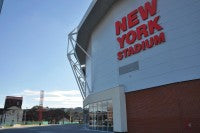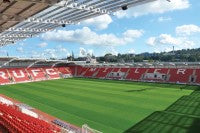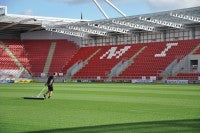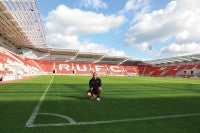Fellowes returns home to Rotherham United
 Rotherham United's New York Stadium was completed in the summer of 2012 and hosted it's first game - a friendly against neighbours Barnsley - on 21st July. The stadium is so named after the area of land it is built on, and chairman, Tony Stewart, mindful that other local stadia - Bramhall Lane, Hillsborough and Don Valley for example - followed that tradition.
Rotherham United's New York Stadium was completed in the summer of 2012 and hosted it's first game - a friendly against neighbours Barnsley - on 21st July. The stadium is so named after the area of land it is built on, and chairman, Tony Stewart, mindful that other local stadia - Bramhall Lane, Hillsborough and Don Valley for example - followed that tradition.
The completion of the stadium saw Rotherham United return to the town after a period of three years playing at the Don Valley Stadium in Sheffield.
"The capacity is just over 12,000, but there is scope to put in an extra 4,000 seats if we go up the leagues," explained David Fellowes, the club's Head Groundsman. "It's the chairman's ambition to be in the Championship as soon as possible, hence why he's built a Championship-style stadium. It was one of the things that attracted me to come to work here; the ambitions of the club."
 David mentioned that some of his friends thought him mad for making the leap from Premiership to League Two, but he explained further: "After Fulham, this has been a new challenge, since I was involved with everything from the very beginning, with the design and construction of the pitch. I was involved with getting the right, clear, roofing to let in UV rays, the tendering and construction process of the pitch and getting the best playing surface with the budget we had. Also, the rubber shock pad going around the pitch and deciding the right sized tunnel for getting machines down onto the pitch and tractors at the end of the season. At Fulham we had no entrance, and we had to take out loads of seats and build a ramp to get in and out to do renovations, so getting that right here was something I was very keen on."
David mentioned that some of his friends thought him mad for making the leap from Premiership to League Two, but he explained further: "After Fulham, this has been a new challenge, since I was involved with everything from the very beginning, with the design and construction of the pitch. I was involved with getting the right, clear, roofing to let in UV rays, the tendering and construction process of the pitch and getting the best playing surface with the budget we had. Also, the rubber shock pad going around the pitch and deciding the right sized tunnel for getting machines down onto the pitch and tractors at the end of the season. At Fulham we had no entrance, and we had to take out loads of seats and build a ramp to get in and out to do renovations, so getting that right here was something I was very keen on."
"The positioning and sizing of storage sheds was something I was involved with as well, because we didn't have them at Fulham either. There, I had to take all the equipment down to a local school on a match day!"
 Obviously, the budget difference from Premiership to League Two is vast, and David listed the machinery used at Fulham, including lighting rigs, a pedestrian sprayer, two Dennis G860s with all attachments, a Toro Procore 648 pedestrian, an aerator and a Dennis Premier.
Obviously, the budget difference from Premiership to League Two is vast, and David listed the machinery used at Fulham, including lighting rigs, a pedestrian sprayer, two Dennis G860s with all attachments, a Toro Procore 648 pedestrian, an aerator and a Dennis Premier.
"So, we had a lot of good machinery there which we spent years acquiring. Compared to here, where we've got a couple of Allett Buffalo 34s, which are good mowers but you can't put different attachments in, and I've got a couple of rotary mowers, and that's about it. It's a far cry from Fulham, but it's just changing the way you work things and manage everything."
"I like to keep things on the pitch as pedestrian as possible, and the only time I would put a tractor on is to vertidrain, at the end of the season to do the renovations or, if I have to, for intermediate tining in between the verti-drains."
 David is a man who likes a challenge, and he was looking to the future and building up equipment for the club. "When I started at Fulham though it was exactly the same as it was here, and it's a challenge to now try and build it up again to the same level as it was there with equipment. The chairman is fantastic here and, so far so good, he's signed off everything I've asked for. Obviously, I haven't taken the mickey asking for stuff, but if I do a business case and he understands I need it, he will purchase it for me. It is a slow process, but we'll get there."
David is a man who likes a challenge, and he was looking to the future and building up equipment for the club. "When I started at Fulham though it was exactly the same as it was here, and it's a challenge to now try and build it up again to the same level as it was there with equipment. The chairman is fantastic here and, so far so good, he's signed off everything I've asked for. Obviously, I haven't taken the mickey asking for stuff, but if I do a business case and he understands I need it, he will purchase it for me. It is a slow process, but we'll get there."
Another difference between the clubs is what can be put on the turf in terms of feed and tonics. David said he was enjoying going back to basics: "Before, I had a fungicide programme whereas, here, it's a question of 'let's just give it a couple more days to see how it develops'. It's part and parcel though, and I'm enjoying it. It's going back to basics and feeding what is absolutely needed and not putting on as many tonics as I used to. That's one of the things I'm finding hard, but I'm enjoying the challenge. Especially since there are three sites to take care of, and only two of us; it definitely keeps us busy."
 "It's a very different way of management because you have to think more and plan further ahead, which I enjoy as it's got me thinking again. Obviously, I have to rely on contractors heavily here with not having the equipment. So I get contractors in to spray, verti-drain and topdress."
"It's a very different way of management because you have to think more and plan further ahead, which I enjoy as it's got me thinking again. Obviously, I have to rely on contractors heavily here with not having the equipment. So I get contractors in to spray, verti-drain and topdress."
The pitch itself was constructed from Fibresand and was sown for the first time earlier this year. J Pugh-Lewis Ltd grew the pitch in and David took charge of it from the beginning of July.
"Fibresand was a good reinforcing material that came within the budget we had. It's helped with the pitch being new because the pore space between all the particles is looser, so the roots have more space to go down. This goes alongside verti-draining and regular aeration because Fibresand tends to go quite firm. So, we verti-drain every twelve weeks or whenever the conditions allow. In between that I'll use a pedestrian spiker."
 The pitch has already been given glowing feedback from referees and coaches. Alongside surface aesthetics, David was much more concerned about the roots of his turf for the health and hardiness of the pitch. "I'm happy because we have 10-12 inches of roots and they're big, thick rootballs that are as strong as they could be. I wanted to get at least that because, in the winter, you lose so much when it shrinks and dries off, so the longer root you can get in the summer, helps for the winter. If it was only 4-5 inches of root, I'd be really worried because we'd only have a couple of inches of root to take us through winter."
The pitch has already been given glowing feedback from referees and coaches. Alongside surface aesthetics, David was much more concerned about the roots of his turf for the health and hardiness of the pitch. "I'm happy because we have 10-12 inches of roots and they're big, thick rootballs that are as strong as they could be. I wanted to get at least that because, in the winter, you lose so much when it shrinks and dries off, so the longer root you can get in the summer, helps for the winter. If it was only 4-5 inches of root, I'd be really worried because we'd only have a couple of inches of root to take us through winter."
"I find all the hard work you put in during the summer, with aeration programmes and developing those roots, pays dividends when you come into winter. I love the science of it and I work to get the trace elements right. It might look alright on the top but, if you've got rubbish roots, the pitch will come to pieces. It's only aesthetics at the end of the day."
And surely there must have been some snags along the way with a project such as this? "There have been a few teething problems, but everything is pretty much sorted now. Things like the irrigation tank which we had to have installed underneath the car park. You can't have mains water running into an  underground tank, so you have to have a header tank. It's like anything, it can't be perfect all the time and it was a great learning curve. Seeing it from just mud, with the drainage getting put in, was valuable as now, if anything goes wrong, I can just refer back to photos I took at the time during the building. It was the good thing, from being involved from scratch and coming in when everything was being constructed, because I know where all the irrigation lines are," David said.
underground tank, so you have to have a header tank. It's like anything, it can't be perfect all the time and it was a great learning curve. Seeing it from just mud, with the drainage getting put in, was valuable as now, if anything goes wrong, I can just refer back to photos I took at the time during the building. It was the good thing, from being involved from scratch and coming in when everything was being constructed, because I know where all the irrigation lines are," David said.
Another large project being undertaken by the club is the building of a new training ground. The pitches that are already there are sloping, so the site needs cutting and filling and then new drainage and irrigation installing. "It's a big project there as well. It's a first for me being involved in something like that from the start too, and I'm very happy to be part of it."
David spoke further about the differences between the two football clubs he has worked for: "Because, at Fulham, the corners to the stadium weren't filled in, we had the air flow. Here, that's not the case, so we get around this by doing more brushing to try and get air moving around the base of the roots to help it dry out. We get a bit more algae build up in the corners because you don't get the light there as well, so I use a fork to try and break up the algae."
 "There was also undersoil heating, compared with frost sheets here. And we had lighting rigs at Fulham, so going from using them to not was a bit of a challenge. I'm working on the chairman though, because he owns a lighting business, so hopefully he can make me some - he's probably more worried about the power they use though! It's the running cost of the rigs that adds up. Also then, there's the extra fertiliser and water here, which is an expense. We're already tight on water and our fertiliser budget."
"There was also undersoil heating, compared with frost sheets here. And we had lighting rigs at Fulham, so going from using them to not was a bit of a challenge. I'm working on the chairman though, because he owns a lighting business, so hopefully he can make me some - he's probably more worried about the power they use though! It's the running cost of the rigs that adds up. Also then, there's the extra fertiliser and water here, which is an expense. We're already tight on water and our fertiliser budget."
David explained an ethos developed at Fulham of which he was proud to apply to Rotherham's pitch: "I think my experience with being at a Premier League club, with the TV coverage, is paying off here, because I'm putting the same preparation and little details into this pitch as the one at Fulham. It's the little details that people don't tend to notice that make the difference. Whether that is something as small as cleaning down the goals with a bucket and sponge pre-match, or trimming around sprinkler heads, which people don't see, I believe they make a big difference. It might take a bit more time and involve a few more hours, but it's rewarding seeing it work and getting all the compliments. It's all aesthetics, and the pitch has to be perfect at the end of the day, because it's the stage the team play on."
